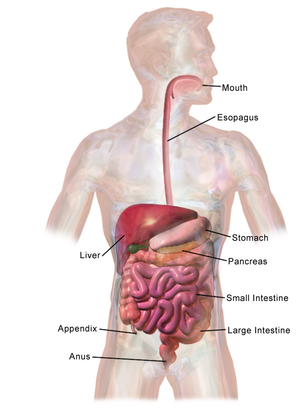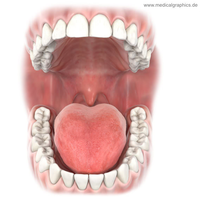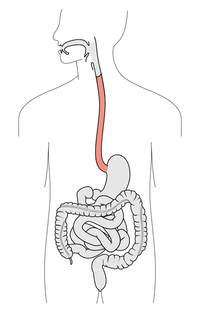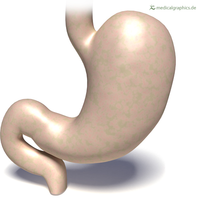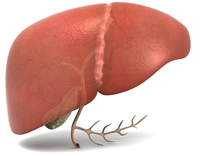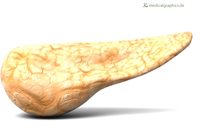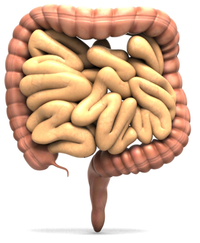Difference between revisions of "Digestive System"
(→Key Stage 4) |
|||
| (3 intermediate revisions by the same user not shown) | |||
| Line 72: | Line 72: | ||
: The '''digestive system''' takes large [[insoluble]] [[molecule]]s and breaks them down into small [[soluble]] [[molecule]]s to be [[Absorb (Biology)|absorbed]]. | : The '''digestive system''' takes large [[insoluble]] [[molecule]]s and breaks them down into small [[soluble]] [[molecule]]s to be [[Absorb (Biology)|absorbed]]. | ||
There are several [[organ]]s in the '''digestive system''' you should know: | There are several [[organ]]s in the '''digestive system''' you should know: | ||
| − | *[[Mouth]] - Breaks down food mechanically with [[teeth]] and adds [[saliva]] using the [[Salivary Gland|salivary gland]]s to | + | *[[Mouth]] - Breaks down food mechanically with [[teeth]] and adds [[saliva]] using the [[Salivary Gland|salivary gland]]s to [[lubrication|lubricate]] the food for it to be swallowed. |
*[[Oesophagus]] - Uses [[peristalsis]] to move food from the [[mouth]] to the [[stomach]]. | *[[Oesophagus]] - Uses [[peristalsis]] to move food from the [[mouth]] to the [[stomach]]. | ||
| − | *[[Stomach]] - Starts | + | *[[Stomach]] - Starts [[Chemical Digestion|chemical digestion]] of food in an [[Acid|acidic]] environment adding a [[protease]] called [[pepsin]] which breaks down [[protein]]s into [[Amino Acid|amino acids]]. |
| − | *[[Liver]] - Makes [[bile]] to [[Neutralisation|neutralise]] [[Stomach Acid|stomach acid]] and | + | *[[Liver]] - Makes [[bile]] to [[Neutralisation|neutralise]] [[Stomach Acid|stomach acid]] and [[emulsification|emulsify]] [[fat]]. |
| − | *[[Pancreas]] - Makes [[enzyme]]s | + | *[[Pancreas]] - Makes [[Digestive Enzyme|digestive enzyme]]s including [[Pancreatic Amylase|pancreatic amylase]], [[trypsin]] (which is a type of [[protease]] and [[lipase]]. |
| − | *[[Small Intestine]] - [[Absorb (biology)| | + | *[[Small Intestine]] - Continues the [[Chemical Digestion|chemical digestion]] of food using the [[Digestive Enzyme|enzymes]] from the [[pancreas]] as well as producing its own [[amylase]] and [[peptidase]]. It then [[Absorb (biology)|absorb]]s food into the [[blood]] through [[villi]] |
| − | *[[Large Intestine]] - [[Absorb (biology)|Absorb]]s water from undigested food called [[faeces]]. | + | *[[Large Intestine]] - [[Absorb (biology)|Absorb]]s [[water]] from undigested food called [[faeces]]. |
*[[Rectum]] - Stores [[faeces]] before [[egestion]]. | *[[Rectum]] - Stores [[faeces]] before [[egestion]]. | ||
*[[Anus]] - A ring of [[muscle]] that holds [[faeces]] in. | *[[Anus]] - A ring of [[muscle]] that holds [[faeces]] in. | ||
| Line 107: | Line 107: | ||
*The [[anus]] holds the [[faeces]] in. | *The [[anus]] holds the [[faeces]] in. | ||
|} | |} | ||
| + | |||
| + | ==Extra Information== | ||
| + | {{#ev:youtube|https://www.youtube.com/watch?v=Og5xAdC8EUI}} | ||
Latest revision as of 16:20, 19 February 2022
Contents
Key Stage 2
Meaning
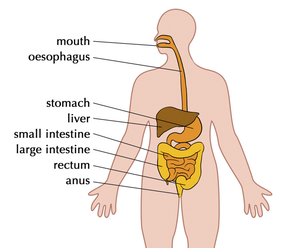
A diagram of the digestive system.
The digestive system is the parts of the body that we use to get nutrients out of our food.
About The Digestive System
- The digestive system breaks food down into small pieces.
- The small pieces can then be absorbed into the body.
- The bits the body does not need leave the body as faeces.
- The digestive system is made up of several parts:
Key Stage 3
Meaning
The digestive system is an organ system that breaks down food for absorption into the blood.
About The Digestive System
- The digestive system breaks down food mechanically and chemically before absorbing nutrients into the blood.
- The digestive system takes large insoluble molecules and breaks them down into small soluble molecules to be absorbed.
There are several organs in the digestive system you should know:
- Mouth - Breaks down food mechanically with teeth and adds saliva using the salivary glands to make food easier to swallow.
- Oesophagus - Uses peristalsis to move food from the mouth to the stomach.
- Stomach - Starts chemical digestion of food in an acidic environment.
- Liver - Makes bile to neutralise stomach acid and break down fat.
- Pancreas - Makes enzymes to chemically digest food.
- Small Intestine - Absorbs food into the blood through villi
- Large Intestine - Absorbs water from undigested food called faeces.
- Rectum - Stores faeces before egestion.
- Anus - A ring of muscle that holds faeces in.
| The mouth is an organ is used to start digestion of food. | The oesophagus is an organ that connects the mouth to the stomach. | The stomach is an organ that digests food. |
| In the digestive system the liver produces bile which neutralises the acid from the stomach and helps break down fat. | In the digestive system the pancreas produces enzymes to chemically break down food. |
|
Key Stage 4
Meaning
The digestive system is an organ system that breaks down food for absorption into the blood.
About The Digestive System
- The digestive system breaks down food mechanically and chemically before absorbing nutrients into the blood.
- The digestive system takes large insoluble molecules and breaks them down into small soluble molecules to be absorbed.
There are several organs in the digestive system you should know:
- Mouth - Breaks down food mechanically with teeth and adds saliva using the salivary glands to lubricate the food for it to be swallowed.
- Oesophagus - Uses peristalsis to move food from the mouth to the stomach.
- Stomach - Starts chemical digestion of food in an acidic environment adding a protease called pepsin which breaks down proteins into amino acids.
- Liver - Makes bile to neutralise stomach acid and emulsify fat.
- Pancreas - Makes digestive enzymes including pancreatic amylase, trypsin (which is a type of protease and lipase.
- Small Intestine - Continues the chemical digestion of food using the enzymes from the pancreas as well as producing its own amylase and peptidase. It then absorbs food into the blood through villi
- Large Intestine - Absorbs water from undigested food called faeces.
- Rectum - Stores faeces before egestion.
- Anus - A ring of muscle that holds faeces in.
| The mouth is an organ is used to start digestion of food. | The oesophagus is an organ that connects the mouth to the stomach. | The stomach is an organ that digests food. |
| In the digestive system the liver produces bile which neutralises the acid from the stomach and helps break down fat. | In the digestive system the pancreas produces enzymes to chemically break down food. |
|
